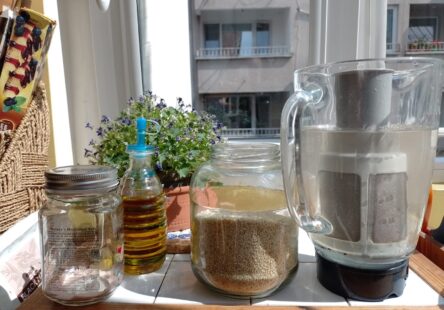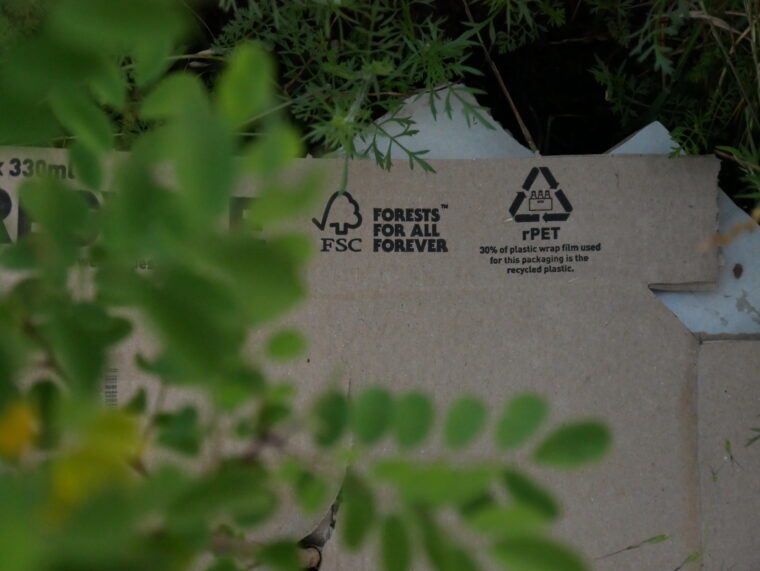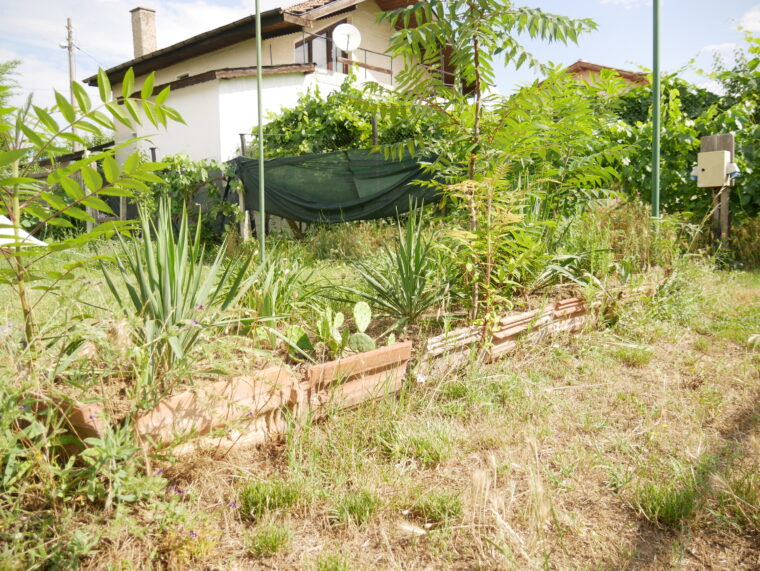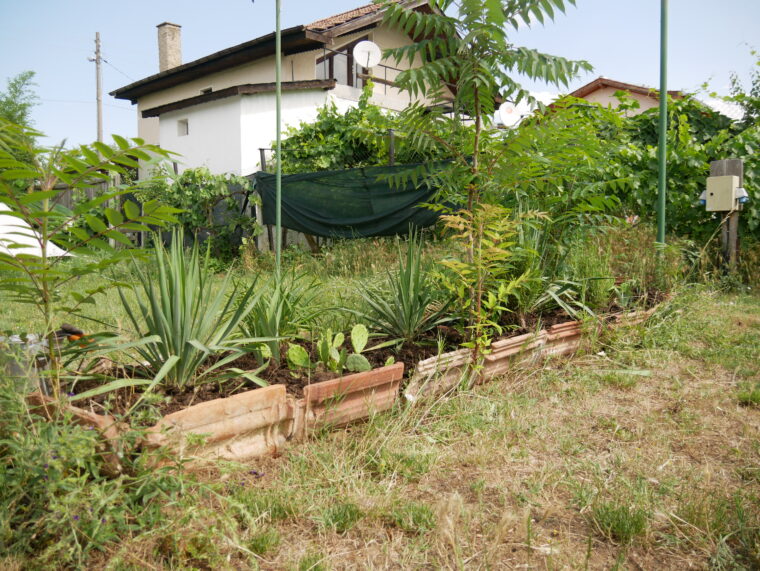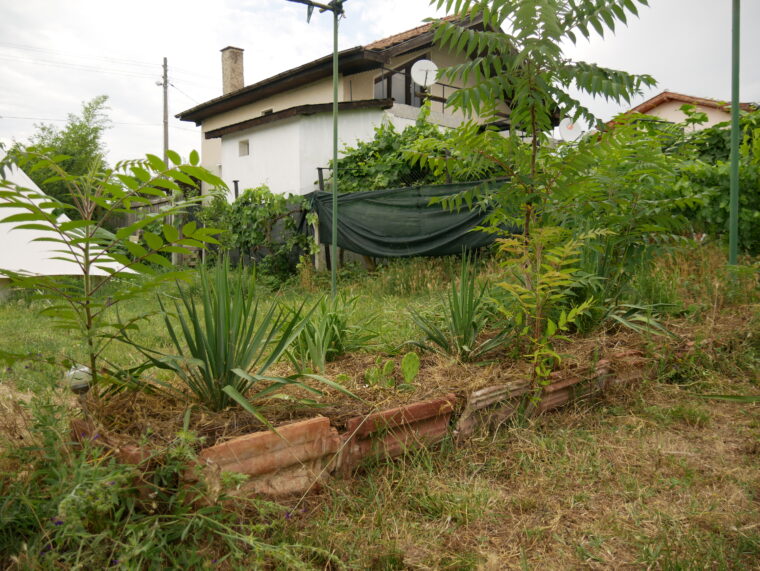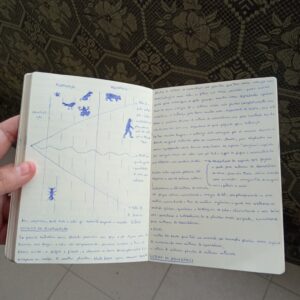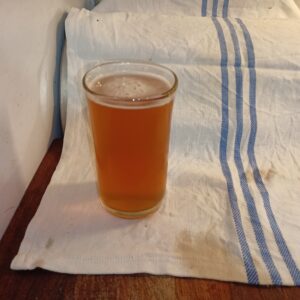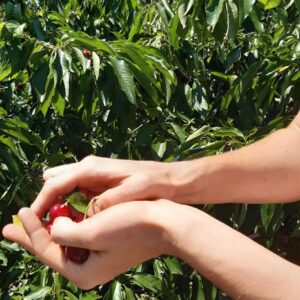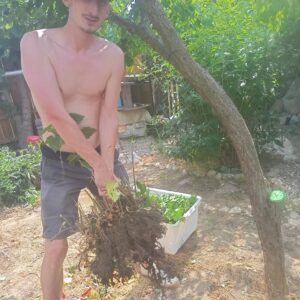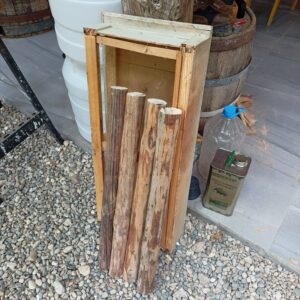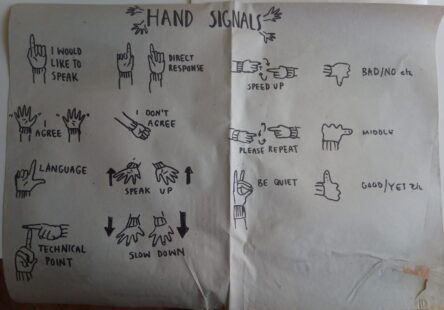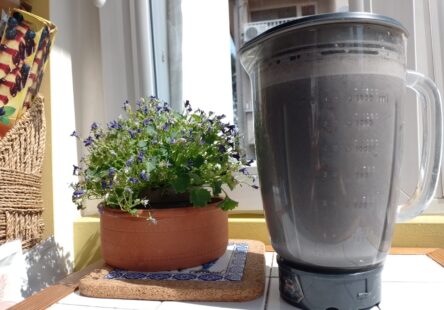Vyara:
Hello, hello! Week 10 it is!
Does anybody remember ‘’The wear sunscreen speech’’ by Mary Schmich? It is one of the most famous graduation speeches ever given, it became viral approximately 10 years ago and it starts with a very simple piece of advice: ‘’wear sunscreen. If I could offer you one tip for the future, sunscreen would be it’’. At the moment I am suffering from terrible sunburn and my advice for you for the summer is: wear sunscreen! Save yourself the pain, the trouble and the inconvenience and put sunscreen on before you go out in the sun. The reason why I got sunburnt is that we were mulching young Acacia trees on a property, which belongs to a regenerative farmer. The farmer is not raising polyculture crops, without using any pesticides, while integrating animals in it. And this is one of the base methods in permaculture for having healthy soil and biodiversity..
I got carried away and worked throughout the hottest part of the day. Thankfully I had one of Filipa`s homemade Calendula creams 🙂
Closing the cycle- reusing cardboard for mulching trees
When these Acacia trees grow big, they will act as a windbreaker, a natural border and their crown will shade and cool the soil. Acacia trees prevent desertification, as their long root system can go down to the water table, the roots also stabilize the soil in areas threatened by erosion. Coming from the leguminous family they have a positive impact on the soil chemistry as nitrogen fixers.
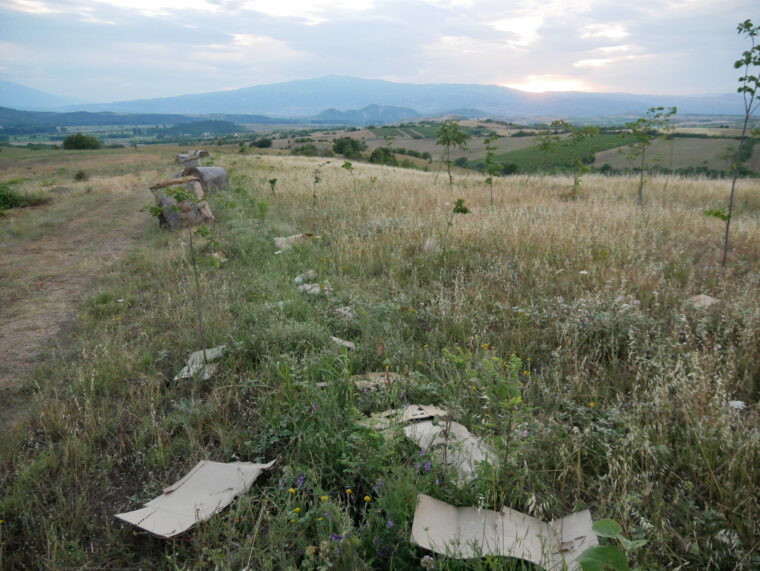
We followed some very simple, yet beneficial steps: we put well rotten cows` mature, cardboard and straw, in that order. The manure serves as natural fertilizer, as the water (from rain and irrigation) leaches through it the nutrients go to the soil, the cardboard will stop any weeds trying to compete with the trees and the straw will keep the moisture in the soil.
Another interesting thing I did this week was tidying John and Sara`s Hugelkulture bed. If you are not familiar with these types of beds, they are no-dig raised beds, famous for holding moisture and fertility. Instead of composting tree cuttings, dead leaves and grass you simply mound them with the help of cardboard/newspapers, manure and compost. The concept for this type of system was born out of the observation of the forest floor by its creator Sepp Holzer.
Еxample of a Hugelkultur raised bed
The continuous decay of the wood is a consistent source of nutrients for the plants and the natural process of rotting increases the aeration and provides heat, extending the growing season. The wood at the bottom retains water and along with good straw mulch it provides constant moisture for the plants in place. You might not need to irrigate the bed as often as other normal raised beds.
Hugel means hill in German, the base drops down with time, while the wood rots, hence why you need to add compost and mulch on top. Which is what I did with this Hugelkulture bed.
Before
During. After the weeding and putting compost, BUT before mulching
Finished and good to go!
This week I decided to keep it simple, yet informative. Hope you like it and see you next week 🙂
Filipa:
Êro, êro! Filipa here and welcome to week 10 😊
Last week I had the opportunity to share with you one of my favourite interests, which I have dabbled in during the pandemic: natural cosmetics! It is a passion that fills my heart and as I loved teaching and explaining to you the process of making an infusion of calendula oil, and from this, as the main ingredient, a calendula balm, I bring one more recipe for you! As with the desire to feel closer to Nature, eventually comes the need to make use of products less aggressive to the body and to the organism we call Earth, since we use dozens of products daily in order to clean, disinfect and perfume our body, but few times we observe what makes up the hygiene and cosmetic products we constantly buy at the supermarket, this is something that needs to be worked on. But when people ask me what connection natural cosmetics have with permaculture, I always remember the harmony we seek, besides one of the principles being not producing waste, so that we are not using products that are toxic and full of single-use plastic when we choose to make our cosmetics at home.
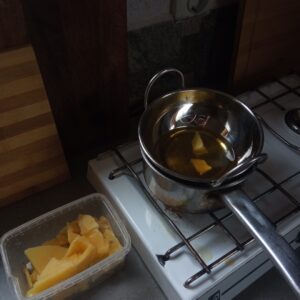
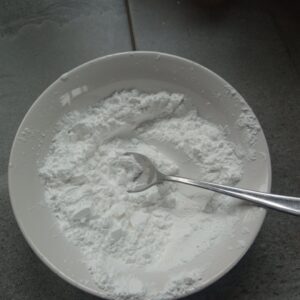
Melting the ingredients in Bain Marie, mixing the dry ingredients and the final result of the deodorant cream
So this week I decided to make natural cream deodorant, not only for my own use, but for the rest of the volunteers and hosts to try. This recipe uses ingredients that you most likely already have in your kitchen, which makes the experience even easier and simpler to achieve. Instead of simply writing down the procedure, I leave you with the process that I documented through photos, as well as some designs, in order to create content for social media and use graphic design, a passion of mine, to make the process more interactive!


Content I’ve created for social media about the deodorant cream
Additionally, this week I decided to venture into one topic that I am really interested in and would love to know more about: syntropic agriculture and farming. I have this Disroot (open-sourced and encrypted version of Google Drive that doesn’t steal your data and sell it to big companies) drive full of permaculture materials – although in Portuguese, it is a nice way to practice my translation skills and at the same time I learn more and create teaching materials/content for social media. The book I am currently reading is called “The Principles of Syntropic Agriculture” by José Fernando dos Santos Rebello, where he dissects the teachings of Ernst Götsch – if you don’t know who he is, he’s a Swiss researcher and farmer, also known for being the creator of Syntropic Agriculture. He is currently in Brazil applying all of his knowledge and became a worldwide sensation because of the results he gathered. For me, having the possibility to learn in Portuguese his teachings, one principle at a time, is actually helping me a lot to see nature with different eyes.
Being completely different from conventional/organic agriculture, in which we work only with 2 dimensions, being length and width, taking into account the two-dimensional spacing, syntropic farming works with 4 dimensions, length, width, height (layer or floor) and time, in which they take the time to maximize the photosynthesis of each plant, while reducing their stress in order to enhance their maximum capabilities. It promotes the harmony between humans and nature, while mimicking the natural behaviour of plants if there was no human interaction to disturb them.


Content I’ve created for social media about the principles of syntropic agriculture
I am currently exploring the third principle and have already learnt so much! I decided to take some pictures of my doodles in the notebook and share some of the content that I am trying to create for social media, so I can engage our followers in this amazing topic.
Before finishing my part of the blog, I wanted to share with you an astonishing fact that I discovered while reading the book: did you know that plants produce 50kg of cellulose each day for every human being on this planet? That being 350 billion kgs of cellulose according to the data of when the book was realised, 2018!

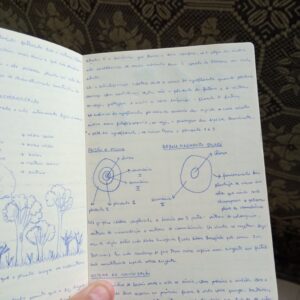
Some of the notes and cute drawings I did on the book I am reading about syntropic agriculture
Thank you for tuning in this week for our adventures, see you next week 😊
Ewan:
Hey hey, Ewan here 🙂 This week was a fairly busy one for me, having to make up for some of the days I lost due to going away in the latter half of last week.
First things first, I finally have the reviews from the beer tasting in! (if anyone is reading this and actually cares). The pale ale is very tasty, refreshing and perfect to have after a long day of work. I would give it a solid 8/10. The red ale, on the other hand, is a bit more on the hoppy side. I think this would be the perfect beer to have in winter sat in front of the fire. And you never know, it may get better with time, since the hosts let the beer carry on fermenting by adding a bit of sugar, so the flavour may very well change over the coming weeks. But as it stands, I would give the red ale a 6/10.
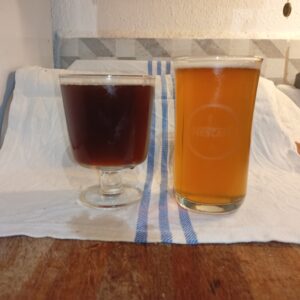
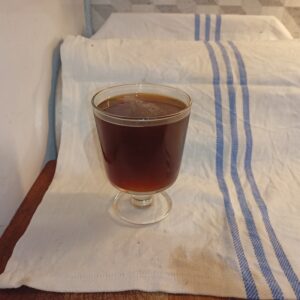
On to the rest of the week, one of the first things I did was help the hosts pick some cherries from the elderly neighbour’s garden. Kromidovo, the village where we are based, has a very old population, mainly consisting of pensioners who spend their time chatting and tending to their gardens. There are, however, some tasks they can’t do, because of their age and lack of mobility. So, one afternoon, me and the hosts headed next door to their neighbour Kiril’s garden, climbed up on a section of their roof, and proceeded to pick bags and bags full of delicious cherries. We managed to keep some of them for our troubles and so as you may have guessed we’ve been eating a lot of cherries this week, either by themselves or in a lovely vegan chocolate cherry cake that Sara baked. But the real satisfaction that came from this task was the feeling that we had helped one of the neighbours. This is something that we really want to work on, as sometimes the villagers don’t have anyone to help them with the tasks they can’t do themselves.

Developing a new dry garden was also on the agenda, with the first stage being to clear the land at the back of the garden of any unwanted plants which are to be repositioned. Two of these plants were blackcurrants, which had never been very productive in this position, so they were dug up to be replanted elsewhere. I’m looking forward to telling and showing you more developments in the dry garden in the coming weeks.
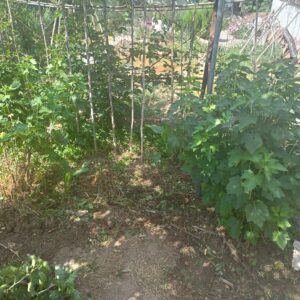

A task that I was very excited about diving into was recycling, repairing and repurposing some old furniture and items that the hosts either had lying around or had found somewhere. The benefits of refusing to buy furniture new (unless absolutely necessary) are endless, and I’m sure you are all already aware of them. So, this was a skill I have been eager to learn for years. One of the aforementioned items of furniture is an old cupboard that a neighbour was throwing away, as it had definitely seen better days, so we decided to turn it into a desk After, with some difficulty, removing the hinges we set about trying to find some suitable pieces of wood to replace the decaying existing ones. These pieces of wood had to be cut to size, to ensure the desk is the right height to be sat at, and then a chunk had to be cut out of each to make a suitable fixture point. You can see where we are at with this project in the pictures, and hopefully next week I will be able to show you the finished item.
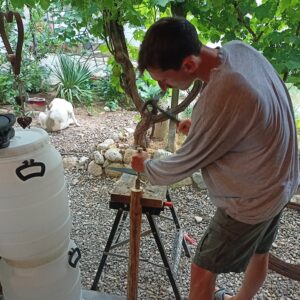
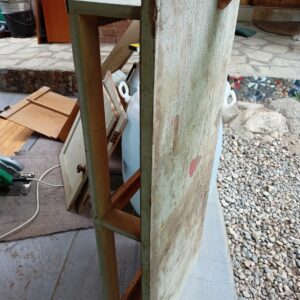
The reason we didn’t get as much work done on the furniture as we would have liked is that a lot of work was done this week on the next big project, the summer kitchen! You may remember me telling you about this in a previous blog post, and this week we made some really good progress on it. After having dug out the foundation, the next step we had to do was connect the water system, since this is one of the main reasons for building the structure. Lots of digging was required for this, and my back is definitely paying the price for that now! But it was worth it, as we managed to get the pipes in position and then cover them back up again, hopefully the grass will grow back properly… We have connected the pipes and they are all working properly, which is a big relief. One of the other main reasons for building this summer kitchen is so the volunteers can use it, and also so the volunteers can upcycle old furniture to be used in the kitchen, and also make some mosaics to decorate it with from old broken tiles. Next week we are going to start the concreting, so once again, stay tuned for more updates 🙂
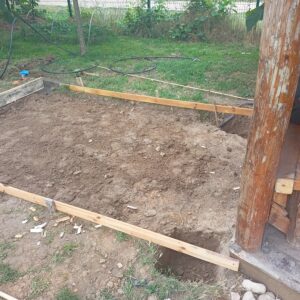
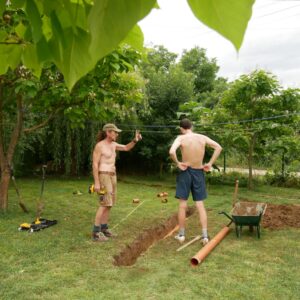
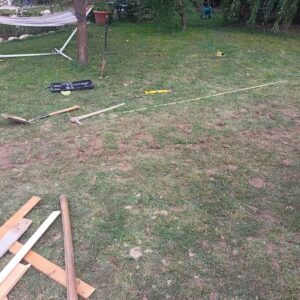

Mali:
Hi from the city!
My second ESC week with Green School Village (GSV) was a varied one and spent mostly in GSV’s office. I received my on-arrival training, including how to use the seven Youthpass competencies as a way to reflect on my learning process. Halfway through the week, I swapped the office for one of the many nice parks that Sofia counts, to write out my hopes and expectations and the impact I imagined this project to have on us volunteers, the hosts, the local people and the coordinator organisation (GSV).
As I have done a permaculture design course before joining this project, one of the goals I set together with Misha is to work towards gaining a teaching permaculture training (TPT) certificate by the end of my six-month project. I have high hopes for the TPT that I might be able to join in Croatia in the last week of June, where Mihaela herself is going to be co-teaching – keeping my fingers crossed!
I have started this week by helping her with sorting out her TPT materials. Imagine a huge and heavy roll of infinite paper posters, that might last perhaps one more TPT training. Misha is always keen on reusing paper as much as possible, which I admire a lot. The TPT she usually gives is based on Rosemary Morrow’s training manual, which despite being really detailed and well-thought out, unfortunately involves a lot of paper being used. Besides the paper overload, her training is also majorly focused on discussions. It misses some interactiveness and outdoorieness. So our common goal now is to rethink and redesign the posters, and with it, some of the exercises connected to them. We’re planning to make them as attractive and timeless as possible, and then laminate them so Green School Village will not have to waste any more paper in upcoming TPTs! For me, this is a really nice start to getting acquainted with the TPT material.
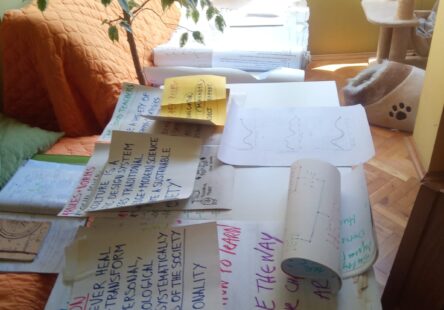
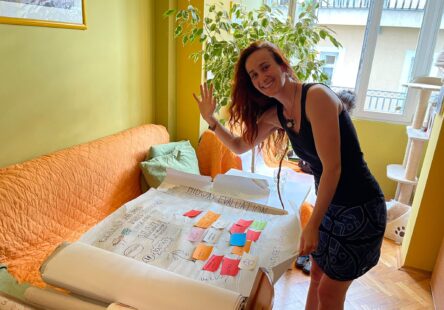
Something totally different that saved me this week with temperatures reaching 35+ degrees was to refresh ourselves with the typical Bulgarian (and generally Balkanic) drink ayran (айран). Very easy to make; just mix yogurt with some water and salt. Really helpful and bliss to a thirsty mouth and overheated head. You can also mix any kind of fresh fruit with it, to give it a nice twist of taste.
Mihaela also let me try boza (боза), another typical drink made of corn, wheat, millet, bulgur or rye depending where you are in the Balkans. According to her, most foreigners actually cannot get this thick fermented malt drink through their throats. But I really liked it! It’s sweet, tangy and … well a peculiar taste that I really hadn’t tasted before. And it’s actually really healthy (supports the digestive system; a great vitamin source and is recommended for pregnant women or women who recently gave birth, thanks to its lactogenic properties). We tried a bottle that Mihaela had bought from a permaculture farm and another organic boza, new to her. The permaculture one won all prizes!
And then another energy booster and nice vegan recipe; making milk from sesame seeds in just a matter of a few minutes! Unlike walnuts and other nuts, you won’t have to soak them overnight to activate the nutrient uptake and remove tannins, phytic acid coating, etc. Black sesame seeds contain more calcium and have a more peculiar taste than white sesame seeds. And did you know that coffee takes out calcium from your bones? So let’s get on with this healthy milk alternative! You’ll need a special blender with a filter, that is really meant only for making these kinds of vegan drinks (see photo). Fill the filter halfway with the sesame seeds and then add water till it comes out of the filter and fills the blender. Then start mixing! You can then also add some oil and salt to your drink and mix some more again. Your black sesame ‘milk’ will look, well, grayish-black. You can lighten it up by mixing it with white sesame seeds to give it a more tasty look. Enjoy experimenting!
